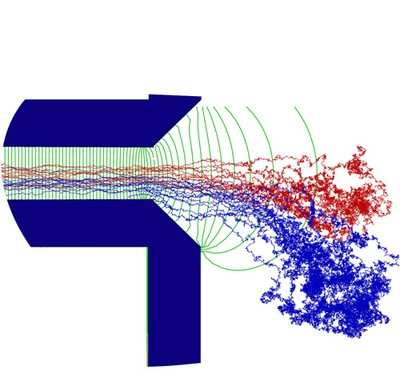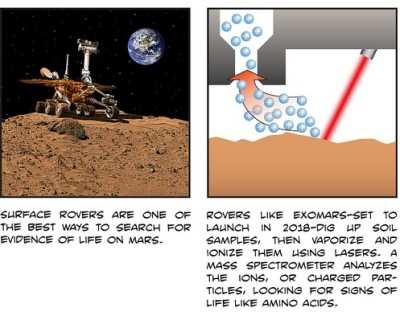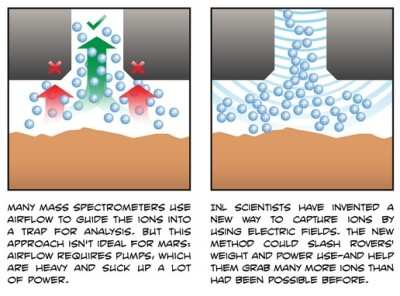Patent Filed For "Total Ion Control" Mass Spectrometry
Device
 Future Mars rovers could have smaller, cheaper and more
sensitive life-detecting instruments, thanks to a new invention
unveiled by scientists at the U.S. Department of Energy's Idaho
National Laboratory (INL).
Future Mars rovers could have smaller, cheaper and more
sensitive life-detecting instruments, thanks to a new invention
unveiled by scientists at the U.S. Department of Energy's Idaho
National Laboratory (INL).
The INL team has found a new way to generate complex electric
fields, which will make it easier to direct ions, or charged
particles, along specified paths. The researchers just filed a
patent application for their Total Ion Control method, a key
advance in the field of mass spectrometry. TIC-based equipment
could make the Mars Organic Molecule Analyzer (MOMA) -- part of the
ExoMars mission scheduled for launch in 2018 -- a better
life-detecting tool.
"This is a novel way to shape electric fields for moving ions
around," said INL engineer and TIC co-inventor Tim McJunkin. "It
can improve MOMA, and it could improve commercial instruments."

Image Courtesy INL
MOMA, a mass spectrometer, will vaporize and ionize Martian dirt
with a laser. The charged particles will flow through an inlet,
down a channel and into a trap, where MOMA will scan them for signs
of life like amino acids. To get ions into the trap, most mass
spectrometers rely heavily on air flow created by pumps. This
system isn't ideal for Mars missions, though; pumps are heavy and
energy-hungry.
TIC technology could assist MOMA. TIC-based inlets generate
intricate electric fields that efficiently guide ions into the
trap, greatly reducing the need for pumps.

Image Courtesy INL
Several other technologies attempt to do the same thing, but
INL's invention boasts many advantages. First, TIC-based inlets
should be cheaper and more robust, because they're simpler to
construct and have fewer parts. Other devices that generate
elaborate, complex fields tend to be elaborate and complex
themselves. They have multiple, precisely configured electrodes,
interspersed with insulators. But TIC-based solutions use only a
single electrode and don't need insulators. They can be made from
many different semi-conducting materials. And the fields TIC inlets
generate are incredibly flexible, so they can be incorporated into
many spectrometer designs.
Space missions demand low-weight, low-power equipment; INL's
invention hits that mark, too. TIC-based inlets weigh less than an
ounce, and they require 100 milliwatts of power at most -- 1,000
times less than a 100-watt light bulb.

Image Courtesy INL
INL says its TIC also gathers 10 times as many ions into the
trap as commercially available inlets do. Such efficiency is key to
MOMA, since any signs of life in the Martian soil will likely be
scarce, if they exist at all.
The INL researchers are talking to the U.S. MOMA team about
incorporating the technology into MOMA. But the invention could
also find many other applications, according to INL scientist and
TIC co-inventor Jill Scott. "This is an enabling technology," she
said. "If you want to move ions around cheaply and robustly, and
without much weight, this is the way to do it."
 Aero-TV: DeltaHawks Diesel Power Steps Into the Spotlight
Aero-TV: DeltaHawks Diesel Power Steps Into the Spotlight NTSB Prelim: Mooney Aircraft Corp. M20K
NTSB Prelim: Mooney Aircraft Corp. M20K ANN FAQ: Turn On Post Notifications
ANN FAQ: Turn On Post Notifications ANN's Daily Aero-Linx (12.20.25)
ANN's Daily Aero-Linx (12.20.25) Aero-News: Quote of the Day (12.20.25)
Aero-News: Quote of the Day (12.20.25)






